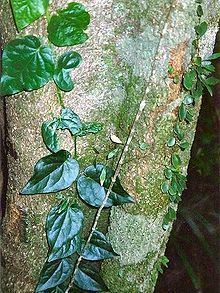Scientific name Piper novae-hollandiae | Genus Piper Rank Species | |
 | ||
People also search for Piper supernum, Piper regale | ||
Piper novae-hollandiae known as the giant pepper vine is a common climber growing in rainforests of eastern Australia. It is related to the pepper plant. It grows north from Mount Dromedary in southern New South Wales to tropical Queensland.
First described by Dutch botanist Friedrich Anton Wilhelm Miquel in 1866, its specific name pertains to its location in New Holland (Australia).
The giant pepper vine is a vigorous and rapid-growing climbing plant with stems which become woody and covered in rough, grey bark. At its greatest development, the woody vine stem can be 40 cm (16 in) thick at the base, and may reach 30–40 metres in length. Of a great age, length and weight. Curtains of leaves may be seen suspended from large rainforest trees. Its thin juvenile leaves measure 8 by 8 cm and are ovate. Also ovate, the mature, or sun, leaves are thicker and larger, and are deep green and veined, and measure 12 cm by 8 cm.
The minute cream flowers occur from April to August. Male flowers are arranged on a cylindrical spike, while female ones are on a more oval one. There is some evidence that the flowers are pollinated by small gall midge flies from the family Cecidomyiidae (Ollerton 1996). Flowering is followed by the 0.5 cm oval-shaped red fleshy drupe, which provides food for rainforest birds such as the white-headed pigeon.
Uses
The giant pepper vine is too vigorous for the average home garden, but has been used in larger parks and gardens, and as an indoor plant.
